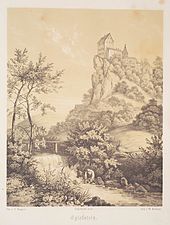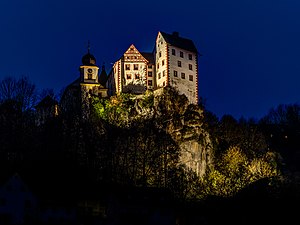Egloffstein Castle
| Egloffstein Castle | ||
|---|---|---|
|
Egloffstein Castle |
||
| Creation time : | Around 1150 | |
| Castle type : | Höhenburg, spur location | |
| Conservation status: | Received or received substantial parts | |
| Standing position : | Barons | |
| Place: | Egloffstein | |
| Geographical location | 49 ° 42 '9.4 " N , 11 ° 15' 26.6" E | |
| Height: | 443 m above sea level NHN | |
|
|
||
Burg Egloffstein is a former high medieval nobility castle that the town of the same name just west Egloffstein in the Upper Franconian district of Forchheim in Bavaria is.
The castle can be visited for an entrance fee.
Geographical location
The Spornburg is located in the Franconian Switzerland-Veldenstein Forest Nature Park at 443 meters above sea level on a bilateral sloping rocky outcrop of the Rabenstein, about 80 meters above the village in the Trubach Valley in Franconian Switzerland .
Located near the castle Thuisbrunn , the castle Hundshaupten and ruin Wolfsberg . The old castle stables on the Altschlossberg near Affalterthal, the Dietrichstein castle stables near Lützelsdorf and the castle stables on the Zaunsbacher Berg and Thüngfelderstein as well as the former castle near Heidhof on the Schlossberg are in the vicinity of Egloffstein.
History of the castle
The lords of Egloffstein are documented since 1180. The castle was not mentioned until 1358, when Albrecht II von Egloffstein founded a chaplaincy there with his brothers, but it is likely to be much older. The Lords of Egloffstein initially owned the castle as free property .
During a feud with the Bishop of Bamberg, Götz von Egloffstein withdrew to the Egloffstein ancestral castle after the destruction of his Leienfels Castle in 1372 . So that this was not besieged by the Bishop of Bamberg, Götz von Egloffstein was excluded from the family association in 1374.
In 1376 the Bamberg bishop Lamprecht von Brunn (1374-1398) forced Seybot II von Egloffstein to grant the Bamberg bishopric the right to open most of the castle.
During the First Margrave War in 1449/50, the castle was attacked unsuccessfully by the troops of Margrave Albrecht Achilles on April 8, 1450, but was badly damaged. From 1482 to 1493 it was significantly rebuilt.
In 1509 Jobst I von Egloffstein gave his part of the castle to the Bamberg Monastery as a fief . In 1516, Wolf I von Egloffstein assigned the last remaining free remainder of the rule to the Bamberg monastery as a fief. The reason for this is likely to be found in the financial situation of the gentlemen von Egloffstein.
Despite the constant strengthening of the defense works, the castle was conquered by the Nuremberg people in the Landshut War of Succession in 1504 and partly burned down. Hardly rebuilt, it fell victim to the Peasants' War in 1525 . The reconstruction was only partial and very slow.
In connection with disputes between Wilhelm III. von Egloffstein and Bamberg Bishop Veit II von Würtzburg (1561–1577) had the castle occupied and devastated in 1563.
When the village of Egloffstein was attacked by the Swedes in the Thirty Years' War in 1632 and 1645, the castle suffered severe damage, so that extensive restoration work was necessary. Albrecht Christoph von Egloffstein had a large gun turret built in 1664.
The castle survived the last war-like occupation in the War of the Spanish Succession in 1703 without major damage. The following decades did not result in any destruction of the castle.
In 1750 the brothers Albrecht Christoph Karl and Ludwig I von Egloffstein had the current parish church of St. Bartholomew built instead of the lower bower with the old castle chapel. In 1800 the large turret collapsed and was dismantled.
The baronial patrimonial court at Egloffstein Castle existed until 1848. The castle is still owned by the Barons of Egloffstein.
Building description
The main or upper castle of the former castle complex still exists. It mainly consists of the old bower and the long bower. The oldest parts of the castle, which may date from the 12th century, are likely to be contained in the old bower. The parish church of St. Bartholomew was built in 1750 in place of the castle chapel .
- Pictures of the castle
literature
- Ursula Pfistermeister : Well-defended Franconia - Volume 3: Castles, fortified churches, city walls around Bamberg, Bayreuth and Coburg . Fachverlag Hans Carl, Nuremberg 2002, ISBN 3-418-00387-7 , pp. 44–45.
- Walter Heinz: Former noble residences in the Trubach valley . Verlag Palm and Enke, Erlangen and Jena 1996, ISBN 3-7896-0554-9 , pp. 130-180.
- Gustav Voit, Brigitte Kaulich, Walter Rüfer: From the countryside in the mountains to Franconian Switzerland - a landscape is discovered . (Publication series of the Franconian Switzerland Association, Volume 8) Verlag Palm and Enke, Erlangen 1992, ISBN 3-7896-0511-5 , pp. 99-103.
- Gustav Voit, Walter Rüfer: A castle tour through Franconian Switzerland . Verlag Palm and Enke, Erlangen 1991, ISBN 3-7896-0064-4 , pp. 36-42.
- Hellmut Kunstmann : The castles of south-western Franconian Switzerland . Commission publisher Degener and Co., Neustadt an der Aisch 1990, pp. 218-229.
- Björn-Uwe Abels , Joachim Zeune , among others: Guide to archaeological monuments in Germany, Volume 20: Franconian Switzerland . Konrad Theiss Verlag, Stuttgart 1990, ISBN 3-8062-0586-8 , pp. 156-157.
- Karl Bosl (ed.): Handbook of the historical sites of Germany . Volume 7: Bavaria (= Kröner's pocket edition . Volume 277). 3. Edition. Kröner, Stuttgart 1981, ISBN 3-520-27703-4 .
- Toni Eckert, Susanne Fischer, Renate Freitag, Rainer Hofmann, Walter Thousand Pounds: The Castles of Franconian Switzerland - A cultural guide . Gürtler Druck, Forchheim o. J., ISBN 3-9803276-5-5 , pp. 42-46.
Web links
- Homepage of the castle
- Entry on Egloffstein in the private database "Alle Burgen".
- Egloffstein Castle. House of Bavarian History (plans, history, building history, building stock)
- History of Egloffstein Castle
- Foracheim: Egloffstein Castle











